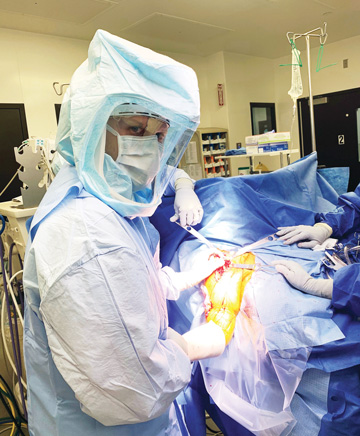Seal wounds with any type of waterproof dermal glue. On top of that, use a transparent medical dressing. It’s waterproof, and patients can see the incision without taking it off. If they become concerned because of some redness or if
it appears it might be draining, they can simply send you a photograph for guidance. You don’t have to worry about patients risking infection by removing their dressings just to show you what they’re worried about. These transparent
dressings work especially well for shoulder arthroplasty because the incisions are relatively small, and gravity helps them to not swell to worrisome levels.
For hip and knee replacements, however, silver-impregnated dressings have changed the game for orthopedic surgeons. Not only are they waterproof, but they can also handle a fair amount of fluid in the event there is drainage from the surgical
wound. For hip and knee cases, most surgeons still use layered closures instead of staples, a traditional closing option with steadily declining popularity. After all, good subcutaneous wound closures are waterproof, and the ones achieved
by using staples are not. The only rationale for continuing to use staples is the time-savings they provide.
Arthroscopy is a little different because the portal sites are small. While you can use absorbable sutures, nonabsorbable ones are often more appropriate. The same waterproof dressings should be used, but the dermal glue isn’t necessary.
A 4x4 transparent dressing on top of the stitching is generally sufficient here.
• Vacuum suction dressings. Negative pressure therapeutic wound-care devices have improved significantly over the last 10 years and have impacted our core ideas on wound healing. These devices were created to help patients who
had large, ulcerated wounds that prevented surgeons from performing primary closures. The idea was to not only keep the wounds sterile, but to induce a secondary closure of the wound by letting granulation tissue fill in. Early versions
were big, bulky machines that could only be used in hospital settings. Now, however, we have access to small, streamlined devices no bigger than a purse. They’re battery-powered, and patients can clamp and remove the tube from the
dressing, take a shower, then reattach it.
In surgical applications, the surgeon puts the vacuum sponge atop closed incisions. The negative pressure keeps the sponge in place, sucks fluids from the wound and enhances blood flow to the surgical site area. If there’s a potential
dead space in a wound, such as a seroma or hematoma where fluid is collecting, the vac will suction out the fluid and essentially collapse that space so it won’t fill up with fluid again. Bacteria like to penetrate and proliferate
in these spaces, which are hotbeds for infection, so it’s invaluable to have negative pressure devices to compress them.
For nonprimary wounds such as ulcerations or other skin breakdowns, you can cut the vacuum sponge to the shape of the wound and insert it. Placing a clear dressing on top of it and cutting a hole to place the tube creates negative pressure
that will keep the sponge in place as the fluid is removed. Having a wound care nurse change the sponge, dressing and tubing every 48 to 72 hours is best practice because you always want to limit the patient’s involvement in the
process.
• Reconstructive procedures. Orthopedic surgeons should always have a plastic surgeon on call who can perform flap coverage when traditional wound closure becomes problematic. For instance, patients who undergo multiple revision
elbow or ankle surgeries might require wound draining because the surgical sites are mostly skin and bone with very little soft tissue.
The skin itself becomes thinner each time it’s cut and heals — and it often won’t heal in an optimal way. Creating soft tissue around the healing wound might require advanced treatment from a plastic surgeon who would perform
a fascial cutaneous or muscle cutaneous flap. This is critical because exposed bone, for all intents and purposes, should be considered infected bone until proven otherwise.
.svg?sfvrsn=be606e78_3)

.svg?sfvrsn=56b2f850_5)